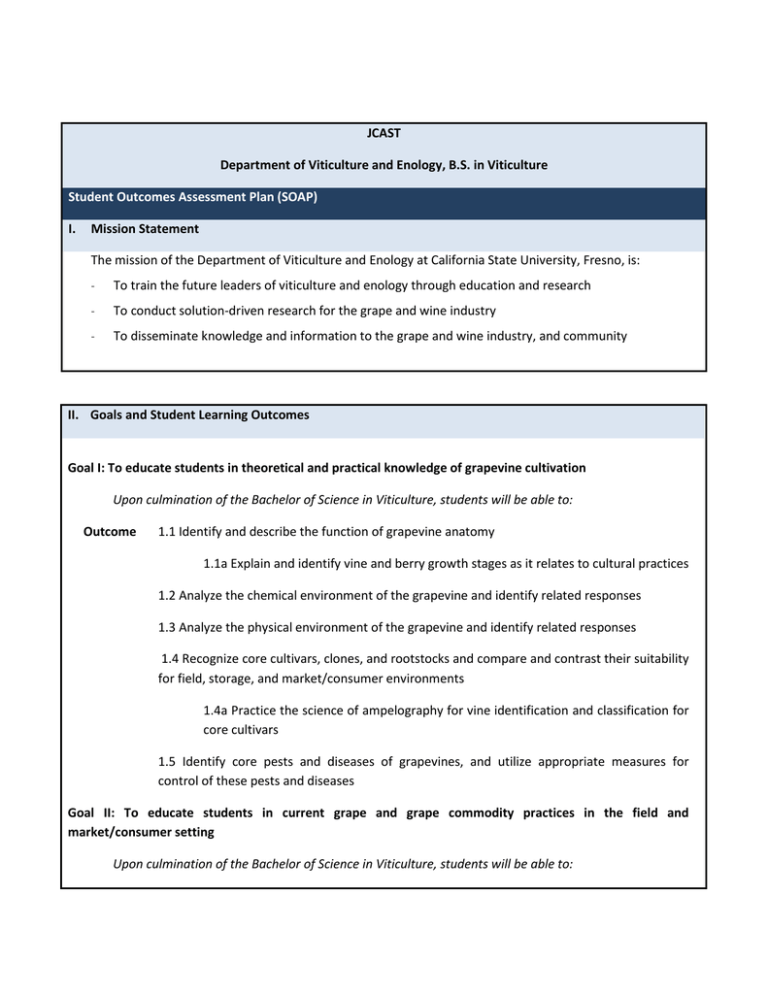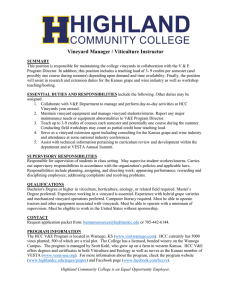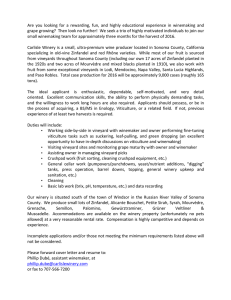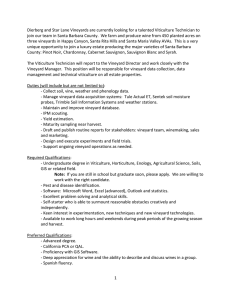The mission of the Department of Viticulture and Enology at... To train the future leaders of viticulture and enology through... JCAST
advertisement

JCAST Department of Viticulture and Enology, B.S. in Viticulture Student Outcomes Assessment Plan (SOAP) I. Mission Statement The mission of the Department of Viticulture and Enology at California State University, Fresno, is: - To train the future leaders of viticulture and enology through education and research - To conduct solution-driven research for the grape and wine industry - To disseminate knowledge and information to the grape and wine industry, and community II. Goals and Student Learning Outcomes Goal I: To educate students in theoretical and practical knowledge of grapevine cultivation Upon culmination of the Bachelor of Science in Viticulture, students will be able to: Outcome 1.1 Identify and describe the function of grapevine anatomy 1.1a Explain and identify vine and berry growth stages as it relates to cultural practices 1.2 Analyze the chemical environment of the grapevine and identify related responses 1.3 Analyze the physical environment of the grapevine and identify related responses 1.4 Recognize core cultivars, clones, and rootstocks and compare and contrast their suitability for field, storage, and market/consumer environments 1.4a Practice the science of ampelography for vine identification and classification for core cultivars 1.5 Identify core pests and diseases of grapevines, and utilize appropriate measures for control of these pests and diseases Goal II: To educate students in current grape and grape commodity practices in the field and market/consumer setting Upon culmination of the Bachelor of Science in Viticulture, students will be able to: Outcome 2.1 Describe and manage the elements necessary for vineyard planning and propagation 2.2. Define and identify situational use of different training, trellising, and pruning systems 2.3 Define and identify situational use of different vineyard mechanization methods suitable for improving production efficiency 2.4 Utilize and manage harvest and post-harvest methods as used in the grape commodity industries 2.5 Demonstrate understanding of the wine grape production process, including unique elements of cultural practices and impact on final product 2.6 Demonstrate understanding of the raisin grape production process, including unique elements of cultural practices and impact on final product 2.7 Demonstrate understanding of the table grape production process, including unique elements of cultural practices and impact on final product 2.8 Express knowledge of grape commodity market terms and practices at national and international levels 2.9 Compare and contrast established marketing and sales practices and demonstrate application to grape commodity markets Goal III: To prepare students with practice in applied skills necessary for grape industry workplace leadership Upon culmination of the Bachelor of Science in Viticulture, students will be able to: Outcome 3.1 Demonstrate the ability to access grape industry knowledge through core resources 3.2 Manage knowledge and information towards achieving project objectives 3.3. Synthesize knowledge and information to achieve objectives and products as assigned 3.4 Communicate, interpret, and evaluate knowledge effectively through oral, written, and visual mediums III. Curriculum Map 1.1 1.1a 1.2 1.3 1.4 1.4a 1.5 ENOL15 Introduction to Enology I I I 2.6 2.7 2.8 2.9 3.1 3.2 3.3 3.4 General Vit I I I I I I I VIT 102 General Vit II VIT 103 Raisin Production/ Processing VIT 105 Table Grapes VIT 106 Winegrape Production R R R R R R R R R I I 2.1 2.2 2.3 2.4 2.5 VIT 101 M= Mastered through Synthesis I I I I I I I R R R I R I I I I I I I I R R M R R M R R R M VIT 160 Mechanized Viticulture VIT165 Varieties/ Rootstocks R R M M R R M R R M M R R R R R R R R R R R R R R R R R R R R R R R R R R R ENOL/VIT 194 Internship VIT 196 Viticulture Projects M M M M M M M M Students will demonstrate mastery through a vineyard management plan designed around a select grape commodity M M M M M M ENOL/VIT 199 Undergrad Seminar Course outcomes and their industry application will be reinforced through lectures delivered by guests from diverse industry sectors Course Outcome R=Reinforced through Application The internship experience will allow students to demonstrate mastery of learned skills through application in an industry setting. Outcomes mastered will depend on internship placement and design. I=Introduced through Instruction III. Assessment Methods A. Direct Measures Method of Assessment: Laboratory Reports (3) Administered in VIT 101, these labs are introductions to core concepts and practices in viticulture. Harvest assessment lab This lab is designed to assess student ability to connect vine morphology and anatomy to metrics influencing harvest decisions and practices. Leaf water potential lab This lab is designed to assess student ability to practice a key method for vineyard management and irrigation practices. Pruning labs This lab is designed to assess student ability to evaluate and practice pruning methods towards vineyard/crop objectives. Benchmark To Be Determined Outcomes assessed 1.1, 1.1a, 1.2, 1.3, 2.2, 2.3, 2.4, 2.5, 2.6, 2.7, 3.2, 3.3, 3.4 Method of Assessment: Vineyard Establishment Report Administered in VIT 102, the Vineyard Establishment and Management lab report is a major project and is designed to be an assessment of student ability to synthesize all course topics into a comprehensive vineyard establishment plan. Benchmark To Be Determined Outcomes assessed 1.1.a, 1.2, 1.3, 1.4, 1.5, 2.1, 2.4, 2.5, 2.6, 2.7, 3.2, 3.4 Method of Assessment: Table Grape Presentation Administered in VIT 105, students research a major table grape-producing country, and prepare an oral presentation analyzing table grape varieties, production practices, and imports and exports. This assignment is designed to assess student ability to perform deep research, synthesize these concepts into a comprehensive report, and communicate that report in an oral presentation. Benchmark To Be Determined Outcomes assessed 1.4, 2.1, 2.2, 2.3, 2.4, 2.7, 2.8, 2.9, 3.1, 3.2, 3.3, 3.4 Method of Assessment: Vineyard Management Report and Oral Presentation Administered in VIT 196, the Vineyard Management project is considered the culminating project of the Viticulture major. Students are required to design a plan integrating their knowledge from all viticulture major courses, creating a document that describes the care of an existing vineyard. Students present their Vineyard Management plans to their peers, assessing their ability to communicate applied viticultural practices orally and visually. Benchmark To Be Determined Outcomes assessed 1.1a, 1.3, 1.4, 1.5, 2.1, 2.2, 2.3, 2.4, 2.5 or 2.6 or 2.7, 2.8, 2.9, 3.1, 3.2, 3.3, 3.4 B. Indirect Measures Graduating Student Exit Survey and Interview Graduating students are interviewed by the department chair, and then are administered a survey to gather their perception of course content, instructors and instruction, facilities, and library resources. See attached survey (Appendix X). Recent Alumni Reflective Survey Recent alumni (3-5 years since graduation) are surveyed to assess their perception of course content, its impact on their performance and growth in the industry, and any gaps in course content reflected by current industry demands. See attached survey (Appendix X). Industry Partners Survey Major, midsize, and small companies who have a record of employing Fresno State Viticulture and Enology graduates are surveyed to assess their perception of Fresno State alumni employee performance in technical, applied, and leadership areas. See attached survey (Appendix X). V. Student Learning Outcomes X Assessment Methods Matrix: Direct Measures Laboratory Reports Vineyard Establishment Report Table Grape Presentation 1.1 x 1.1a x x 1.2 x x 1.3 x x 1.4 x x x 1.4a x x x 1.5 x 2.1 x Vineyard Management Report and Oral Presentation x x x x x x 2.2 x x x 2.3 x x x 2.4 x x x x 2.5 x x x 2.6 x x x 2.7 x x 2.8 2.9 x x x x x x x x x x x x x x x x 3.1 3.2 x 3.3 3.4 x IV. Timeline for Implementation of Assessment Methods and Summary Evaluations Indirect assessments (graduating student survey, recent graduate survey, and industry survey) will be performed annually. AY 2015/2016 Laboratory Reports AY 2016/2017 Vineyard Establishment Report AY2017/2018 Table Grape Presentation AY2018/2019 Vineyard Management Report AY2019/2020 Laboratory Reports V. Process for Closing the Loop The Department of Viticulture and Enology will form an assessment committee, with the Assessment Coordinator serving as chair. The Assessment Committee will be responsible for collecting assessment data, including not only performance data, but also assessment measure design and assessment performance samples. It will be this committee’s charge to analyze these measures, and report to the Department faculty their findings and suggestions for larger discussion and implementation. This data and resulting recommendations/changes will also be reported to the Department chair to serve as a key element of the Department Annual Report. The Assessment Committee will also analyze indirect measures, including discrete assessment programs that impact curriculum and instruction. This practice will support “big picture” thinking in regards to student outcomes, and also connect classroom practices to industry needs, solidifying the Department’s commitment to prepare our learners to be leaders in the grape, raisin, and wine industries.


